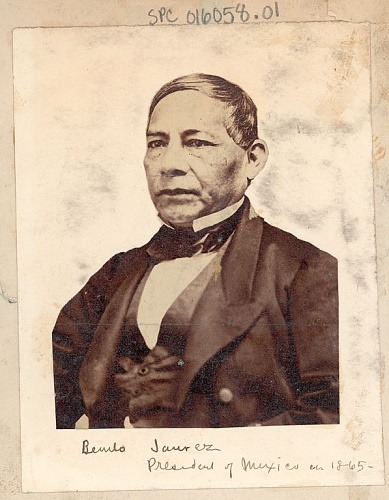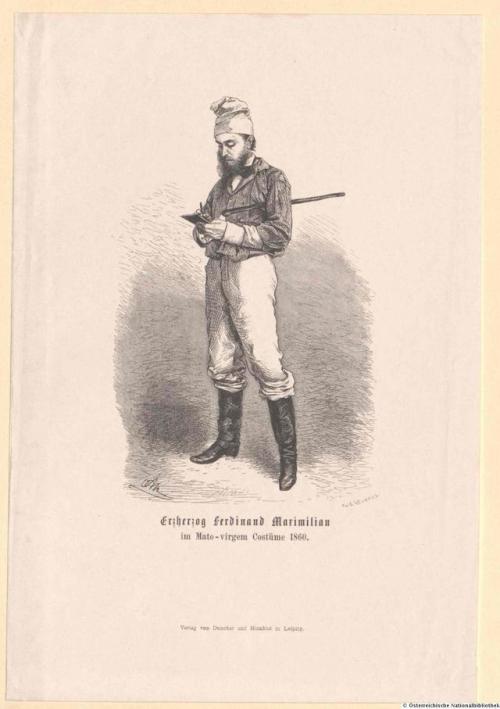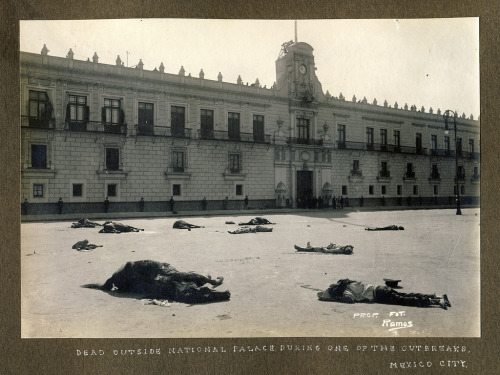#mexican history
Happy Cinco de Mayo! (It’s not Mexico’s Independence Day.)
Cinco de Mayo actually celebrates the Mexican victory over the French at the Battle of Puebla May 5, 1862.
Thisportrait from our collection is of Mexican President Benito Juarez. After reclaiming the presidency post-French invasion, he declared that May 5—the anniversary of the Battle of Puebla—would be a national holiday.

The first Cinco de Mayo celebrations didn’t include margaritas, because they weren’t invented until the 1940s. By the 1970s, the margarita surpassed the martini as the most popular American cocktail.
This is the first frozen margarita machine, invented at a restaurant owned by Mariano Martinez. When blenders couldn’t keep up with the high demand for margs, he found inspiration in the 7-Eleven Slurpee machine. The original retired when Martinez’ restaurant moved 34 years later, and now it’s in our National Museum of American History.
Post link
Mexican Revolutionary Petra Herrera Posed as a Man to Fight for Her Country
In 1998, Disney released its Oscar-nominated film Mulan, an animated movie that followed the heroic adventures of one fictional woman who took her father’s place in the Chinese Imperial Army. In changing her name, training with the troops, and disguising herself as a male soldier, Mulan took actions that might be far from reality, but her story is eerily similar to that of a real Mexican heroine: Petra Herrera.
Unlike Mulan, Herrera’s story isn’t filtered through rose-colored lenses. There is no happy ending, few history books that remember her heroic actions. But Herrera’s valiance and skills as one of the Mexican Revolution’s most successful soldaderas are an example of the bravery and sacrifices women during this time made to change the history of Mexico’s politics — and should not be forgotten.
The year was 1910, and revolutionaries across Mexico were rising up to fight against elitist dictator Porfirio Díaz’s corrupt government. It would be a decade-long bloody civil war that would claim the lives of an estimated 1.5 million people. Herrera herself was killed during that time.
Post link
In 1916, Mexican revolutionary Pancho Villa and about 500 men raided and burned the town of Columbus, New Mexico. The United States later launched a punitive expedition into Mexico led by General John Pershing, but they never got good intel from the locals and didn’t accomplish much of anything.
No one, however, was dumb enough to suggest building a wall along the entire border between the United States and Mexico, because that’s so obviously stupid that oh god damn it.
The Dance of the 41 Maricones
On Sunday, November 17, 1901, police raided a private party and arrested forty-one men, nineteen of them were dressed as women. Those in drag were publicly humiliated by being forced to sweep the streets — “women’s work.” The 41 were taken to an army barracks and inducted into the Mexican army. At least some of them were then put on a train to Veracruz, sent by ship to the Yucatan, and made to serve in the army as it was putting down a Mayan insurgency.
Here is how El Popular reported the story on November 20:
Last Sunday night, the police of the Eighth Precinct were informed that in the house located at number 4 La Paaz Street, a ball was being held without the corresponding permit. They immediately moved in to surprise the culprits, and after having encountered numerous difficulties in trying to get the partygoers to open up, the police broke into the house’s patio where they found 42 individuals who were dancing to the excessively loud music of a local street band.
When they noted the presence of the police, some of those who were dressed in women’s clothing attempted to flee in order to change out of the clothes of the opposite sex; but as the police understood the gravity of the situation, they did not allow anyone to leave, and all 42 including those still dressed as women were taken to the station from which they were then sent to Belem Prison, charged with attacks on morality, and put at the disposition of the District Governor.
As a complement to the previous report, we will say that among those individuals dressed as women, several were recognized as dandies who are seen daily on Plateros Street.
These men wore elegant ladies’ gowns, wigs, false breasts, earrings, embroidered shoes, and a great deal of eye makeup and rouge on their faces.
Once the news hit the boulevards, all kinds of commentaries were made, and the conduct of those individuals was censured.
We will not provide our readers with further details because they are summarily disgusting.
It was said that many of those arrested came from highly respected families with ties to the government of dictator Porfirio Diaz. Some of the earliest newspaper reports, like this one, had it that 42 were arrested. That number later dropped to 41, which generated even more rumors. One had it that the elderly lady who owned the house was one of those arrested, and she was later released. Other, more sinister rumors had it that one of those arrested was one of Diaz’s nephews.
El Popular may have been reluctant to provide details, but in subsequent days it was happy to imagine the scene for its readers:
If only we had seen them in their resplendent hairdos, their fake cleavage, with their shiny sparkling earrings, with their falsies like the ones worn by anemic bimbos, with their corseted waists, their dancing-girl skirts like inverted tulips, their buttery tights, their shoes fringed with crimped gold thread and colored glass beads, and all of them bedaubed in white powder and rouge, prancing about in the fandango with their perfumed and curly mustaches.
On November 23, El Pas published this account of one group of prisoners being transferred to the train bound for Veracruz:
The men-only ball that was raided by the police continues provoking talk in all social circles, by virtue of the fact that many of those detained are perfectly well known, since among them are men who stroll day after day down the boulevards showing off their stylish and perfectly tailored suits and wearing sumptuous jewels.
As we stated in yesterday’s issue, 12 of those captured in the house on the fourth block of La Pazz were sent to Veracruz along with seven thieves who were also conscripted into the armed services.
At 5:30 in the morning, the hour at which attendance is taken in the 24th Battalion (that is being remitted to the port of Veracruz), those called on first were the 12 individuals who had been at the famed ball, and after number 13, who was apelado [a term for a rough, lower-class urban Mexican] was called, he replied on hearing his name, “Present, my Captain,but let me go on record as saying that I am being conscripted as a thief; but I’m not one of them,” and he pointed to the group of dancers.
This provoked the laughter of those present, because not even a thief was willing to be confused with the perfumed boys, as they are called by the soldiers from the barracks
A very amusing scene developed in the the barracks of the 24th Battalion when the repugnant ones arrived wearing their magnificent overcoats, along with hats and nice patent-leather shoes. The captain of the recruits made them all strip without delay, and then handed out the rough but honorable articles of clothing that are given to recruits.
With tears in their eyes, they stripped off all their clothes, some of them begging that they be allowed at least to keep their nice silk undergarments, a request that the captain denied, since, he told them, there they were just the same as everyone else. He didn’t even allow them to keep their socks, and they all began to cry as they put on the shoes that would replace their lovely patent leather ladies’ shoes.
The government paper, El Imparcial, took plains to deny that the army was foolish enough to send any girly-men to the front lines:
All of the prisoners have been sent to Yucatan, but not as it has been said to join the ranks of the valiant soldiers taking part in the campaign; they will be employed instead on such tasks as digging trenches, opening breaches, and raising temporary fortifications.
Today, the number 41 has become slang for homosexuality or, more specifically, “faggot” or maricon. As the former revolutionary general and National Defense Secretary Francisco L. Urquizo explained in 1965, “The influence of this tradition is so strong that even officialdom ignores the number 41. No division, regiment, or battalion of the army is given the number 41. From 40 they progress directly to 42. No payroll has a number 41. Municipal records show no houses with the number 41. No hotel or hospital has a room 41. Nobody celebrates their 41st birthday, going straight from 40 to 42. No vehicle is assigned a number plate with 41, and no police officer will accept a badge with that number.” Some of the early LGBT advocacy groups in Mexico incorporated the number into their names, just as many similar groups in the U.S. have leveraged “Stonewall” as a shorthand for the struggle for gay rights.
Post link
On This Day In History
May 3rd, 752: King Yaxun B'alam IV (Bird Jaguar IV) of the Maya city Yaxchilan assumes the throne.
Soldiers, Priests, Convicts (see Starr p47)–the earliest European colonists in California sound like an odd mix and one in tragic lack of estrogen. So when we discuss the position of women in California, especially in the earlier part of this question, what is really being asked about is the lives of specifically Native, Indian Women.
The groups of historians that Castaneda examined are all tinged in their own ways with misguided perspectives based on ego or racisim, and only since the later half of the twentieth century has serious study been undertaken to understand the histories of women and non-Europeans. Kevin Starr himself doesn’t seem to have too much to offer on the role of women in this period, though he does describe on page 47, that there was very little inter-marriage in California, as opposed to the case in other parts of colonial Spain where classes of mixed-race citizens were generated. It is rather telling that a white mans inclusion of women’s history means a detail on marriage.
It was very interesting in the Castaneda article, that while these early historians “fundamentally reflect the political and socio-racial ideology that informed both the war with Mexico and the subsequent socio-political and economic marginalization of Mexicans in California” (p8) what little positive report they did draw upon was from those Euro-Americans that had been to California in the decades before war, as part of those merchants and traders coming to aid the region and diversify society when Spain could not maintain the colony by itself. Starr identifies inter-national marriage in a limited sense, describing how some of these merchants married into the established Spanish-Mexican wealthy families in the days after independence from Spain. However, his description is a rather uninformative list, again dumbly focusing on the issue of marriage [p.59].
After the war the discourse becomes more negative it seems, and its interesting to note the narratives of fantasy of “Spanish-speaking women [who] invited the advances of EuroAmerican men whom they anxiously awaited as their saviors from Mexican men” [Castaneda, p10]. This American type of narrative sounds a lot like those first fantastic tales and romances of Calafia that motivated the first Spanish explorers, even though Starr described this as the heeding of a “medieval mindset” different from contemporary mindsets presumably, but errantly, for here the same theme continued in the minds of Americans in the 19th and 20th century.
The realities for non-white women seems to have changed little from the mission-presidio days, through to its colonization by white Americans. Castaneda says “conquest and racism intensified sexual assault… non-white women could be raped with impunity, just as they could be enslaved, killed, or worked to death.” [p15].
Castañeda, A. I. (1990). Gender, Race, and Culture: Spanish-Mexican Women in the Historiography of Frontier California. Frontiers: A Journal Of Women Studies, (1), 8.
I’ve been jotting down some really interesting notes about United States Press coverage, and government propagandizing, from the period of the Mexican American War. Its amazing how much these narratives have in common with the fantasies of former colonizing Europeans, and then even through the 20th century, (the Zoot Suit Riot era headlines could stand in for those durring the actuall War in the 1840s).
Specifically a lot of these public stories will deal with the notion of liberating exotic women from their naturally brutish and impotent men. Even more recently, Kevin Starr in his book California, chalks the riots up to “teenage jealousies” – an offensive reduction, especially given the collusion of adults in the mainstream press, the LAPD, and civilian vigilante mobs.
Girl from Greece (left) and girl from Mexico (right) in their traditional national costumes
Post link

The Mier Expedition: The Drawing of the Black Bean, Frederic Remington, 1896
The dead outside National Palace during one of the outbreaks of the Mexican Revolution, Mexico City, c. 1913
Source:Southern Methodist University, Central University Libraries, DeGolyer Library.
Post link

Emperor Maximilian I of Mexico

Emperor Maximilian I of Mexico

Empress Charlotte of Mexico

Emperor Maximilian I of Mexico

Emperor Maximilian of Mexico

Emperor Maximilian of Mexico










